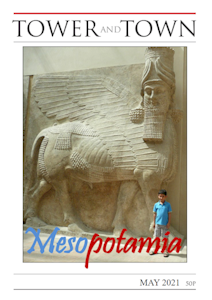

Tower and Town, May 2021 (view the full edition) (view the full edition)Mesopotamian Heritage And HopeThe location of Mesopotamia (Iraq) between the warring Persian and Byzantine empires, in proximity to the Holy Land, and its Christian and Islamic roots, shaped its destiny. Western interest was given momentum during the early part of the 19th century by those curious about the roots of Western Civilization and archaeological treasures. This continued well into the 20th century, when interest in another treasure, oil, was also ignited. Below is a highly selective overview of Mesopotamia's ancient and Islamic heritage aimed at making some sense of the aftermath of the fateful 2003 western invasion of Iraq . The text includes the recurring theme of the March 2021 visit to Iraq by Pope Francis - viewed here as a declaration of hope.   It was Neil MacGregor who, whilst at the helm of the British Museum in London, stated the following: “Modern cities everywhere have Mesopotamia in their DNA”. After all, his reasoning is well supported by the archaeological evidence of developed urbanisation, including governance and administrative written records. In addition, Mr MacGregor went further by including several objects from Mesopotamia (modern Iraq) in his acclaimed radio broadcasts 'A History of the World in 100 Objects'. One of them is the Standard of Ur from 2600-2400 BC, a finely wrought wooden box inlaid with shells and lapis lazuli with panoramas depicting life in ancient Sumer. It was excavated at the Sumerian city of Ur which recently captured the international headlines. It was on Saturday 6 March 2021 that Pope Francis presided over an interreligious meeting at the Plain of Ur, birth place of Abraham, celebrating diversity in Iraq.  A 3100-3000 BC clay writing tablet measuring 9x7 centimetres was also rightfully chosen by Neil MacGregor. This Lower Mesopotamian object is in fact one of the earliest examples we know of writing and how to use it to administer society. This prompts me to point out that as pictographic writing developed into cuneiform, the foundations of civilized society, resting on written language, came into being. Also around 2300 BC the Semitic Akkadians led by Sargon the Great, conquered much of Sumer. But in the 21st century BC the Sumerians rose again under the third dynasty of Ur. From this era thousands of documents have been excavated, including the earliest known written code of law, that of the Sumerian King Ur-Nammu. The other point which is worthy of our attention is that, with the flowering of the Babylonian and Assyrian empires during the second millennium BC, the tradition of recording on clay tablets was adopted further north. In fact one of the greatest discoveries of cuneiform inscriptions was the first millennium BC library of Assurbanipal at Nineveh, the capital of Assyria near Mosul in northern Iraq, which was excavated in the 1850's by a British archaeological team. Its 25,000-odd tablets and fragments are inscribed in bilingual Sumerian-Akkadian texts that are literary and religious works, incantations and letters, as well as diverse astronomical, medical and lexicographical writings. The library was established in the seventh century BC by the Assyrian King Assurbanipal, and it contained among its tablets that of the Flood, which was rightfully included in 'History of the World in 100 Objects'. The Nineveh Plain is, of course, where the Assyrian colossus, a human headed winged bull, Lamassu, is traced. Zoroastrianism from Persia plus the flourishing of the Abrahamic faiths (Judaism from Babylonian-instigated exiles, first in 597 BC, and Christianity's arrival during its first century) have had direct effect on the course of Mesopotamian history. This cosmopolitanism proved to be significant in the aftermath of the Arab Muslim conquest of 636 AD. Native Christians and Jews played important roles during the golden age of Islam when the empire was ruled from Baghdad, founded by the Abbasid Caliph Mansur in 762 AD. The Abbasid court admired scholarship and noted relevant practices of the Sassanians in Iran and also of their caliph predecessors, the Umayyads in Damascus. They established in Baghdad Bayt Al-Hikma, (House of Wisdom), to which multi-lingual Christian scholars belonged, joined by converging thinkers from the Islamic empire in order to preserve the heritage of Greek knowledge and expand on it in mathematics, astronomy and medicine. It was under Al-Mansur, Al-Rashid and notably Al-Ma'mun (813-833 AD) that Arab scholarship, art and architecture reached their zenith, turning the period into yet another Mesopotamian epoch in human history. This, however, came crashing down when the terror from the Mongolian steppes of Central Asia finally arrived. Three armies of Hulegu, the grandson of Jingiz (Genghis), converged on Baghdad in 1258 AD, massacring its population and decimating its heritage. The last two decades have been like Hulegu 2.0 for many Iraqis. However, the Pope's message is that hope should not fade away. (You can access the events of the Pope's visit to Iraq via the Travel section of the Vatican's website vatican.va). Raik Jarjis |